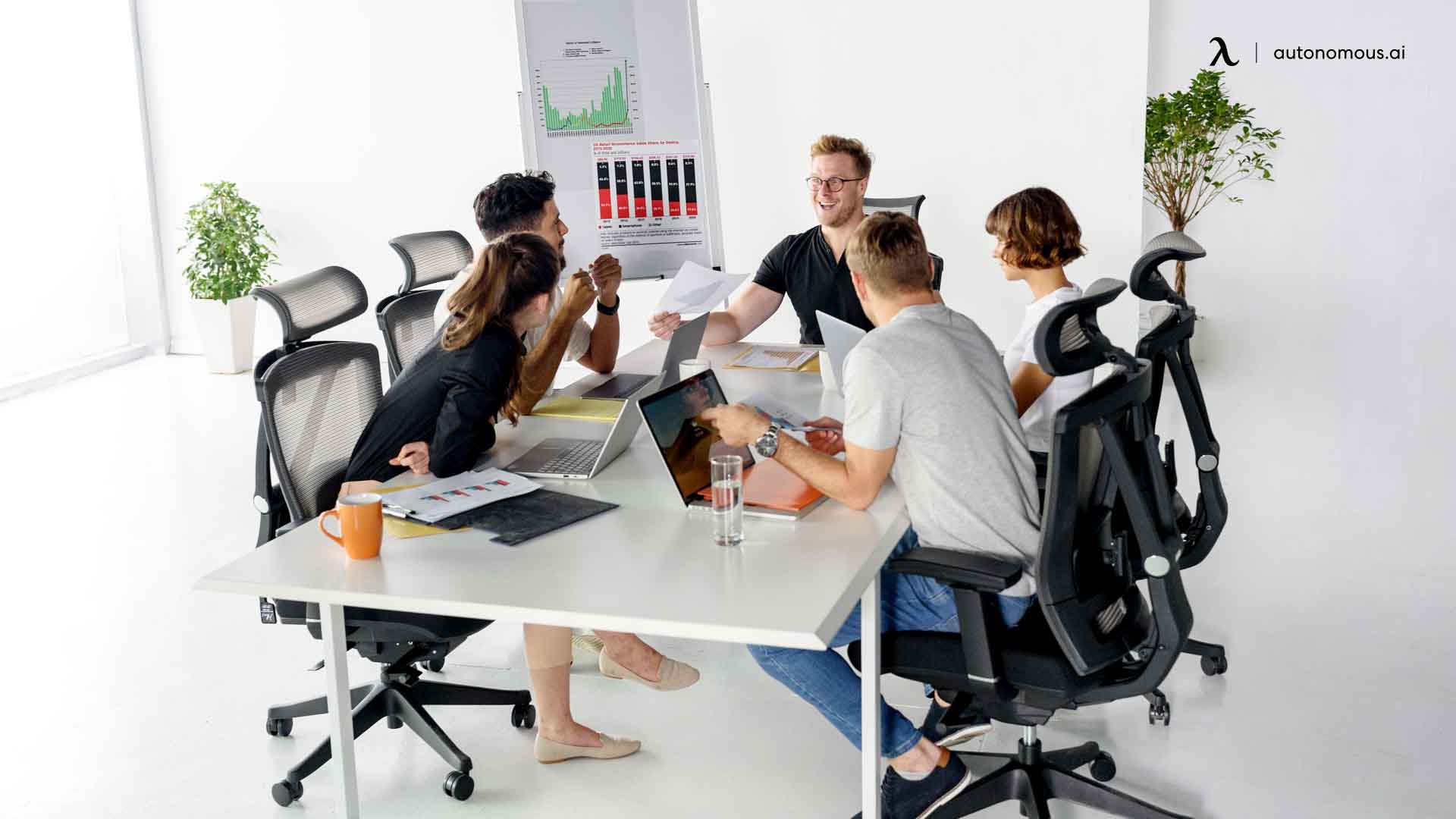/https://storage.googleapis.com/s3-autonomous-upgrade-3/static/upload/images/new_post/best-practices-for-a-hybrid-workplace-setup-1582-1617870732741.jpg)
Creating a hybrid workplace has become a necessity for a lot of businesses, thanks to the new reality imposed by the COVID-19 pandemic. Any affected business unwilling to change could or has already suffered adverse consequences.
Business owners and managers have a job to navigate a company through typical and uncharted waters with the same level of effectiveness. Therefore, there is an expectation to be able to thrive on and even come out on the victorious side of chaotic events. Well, not many happenings have caused as much chaos as this one, and that means managers and business owners need to step up in a big way.
With social distancing orders and potentially even work from home requirements, organizations still need to meet whatever targets they have. That is how a hybrid work environment comes into the mix, as when accommodated well, it allows employees to complete their tasks and meet their targets without having to be in a physical workspace and expose themselves two the risk of contracting COVID-19.
What Is a Hybrid Workplace?
To get the hybrid workplace meaning, it is good to understand the two alternatives that it sits between. On one end of the spectrum, there is the traditional office context where people must work from a physical office location to get their tasks done. On the other end, there is the remote work style that allows employees to complete their tasks from a remote location.
A hybrid work model sits somewhere between the two. The pandemic prevents a full return to the traditional office setting, but not all workers have a job that permits them to always work from home. Therefore, the best bet is to find a sweet spot somewhere in between.
Note that the model that works for other businesses may not necessarily work for your business.
The Six Stages of Making a Hybrid Workplace
Even businesses with a business continuity plan in place had no idea that COVID-19 was going to have the massive effect that it did. Therefore, the pandemic called for strategizing and restructuring. One great way to go about this is to consider all the potential states that your business could potentially go through and develop a strategy that allows you to switch between these states. These are the stages of the hybrid Workplace, and they are as follows:

- The first stage is the worst-case scenario, and this is complete closure. Depending on your company context, this could take several forms. You may even not be able to operate at all. The most important considerations here are remaining prepared to reopen rather marginally or completely when the time comes and retaining your workforce.
- Stage two in a hybrid work environment is the mandatory work from home level. You do not have closure here, but it is not necessarily a hybrid design, as the remote work is an order as opposed to an option. Typically, this would be because of whatever is mandated by your government. However, some companies decided to take things into their own hands and enforce a work from home order on staff members to minimize the risk of the COVID-19 spread.
- Stage three is where the productive work from home schedule starts to come into the mix. At this point, you can have employees work from the physical office, but it is not the preferred option. Instead, you encourage employees to work from home with no subtlety whatsoever. While you are not going to force the directive as you probably would at stage two, you actively discourage any decision which does not lead to working from home.
- Stage four is next, and this is the soft open stage of a hybrid workplace. At this stage, though the business may be open for employees to work, some special provisions and augmentations govern doing so. The encouragement to work from home is still present here, though it may not be as strong. The soft open is essentially a pilot phase where managers and business owners can evaluate the readiness of the business to truly open by creating and observing a controlled work context.
- Next, there is stage five of hybrid work environment, and this is much closer to the traditional state of being open. Here, restrictions are put in place, which allow people to do work as they usually do while remaining safe and minimizing the risk of contracting the virus. Even at this stage, though it is in small parts, workers are still encouraged to work remotely.
- Stage six is the final one of hybrid workplace and requires the COVID-19 virus to no longer be as big a threat as it is now. ideally, the virus would have transitioned to more of an endemic stage, which means that the multitude of measures put in place to mitigate its spread and effect would no longer be necessary. At this point, the encouragement to work from home is no more, and staff members can proceed as they used to before the pandemic became a problem.
Tips to Foster the Best Hybrid Work from Home Experience
Focus on Employee Feedback
Regardless of how large your company is and how much you may have poured into your risk assessment and management department (if you have one), it is very unlikely that you anticipated COVID-19 well or had a prior experience that helps to navigate the situation. The emergence and effect of the coronavirus are unprecedented, which means though you may have established a strategy, much of what your business may do is trial and error.

Your workforce is at the center of the changes, and as the ones carrying out the operational work, their input is priceless. If you have typically taken the stance that managers know best and should make all the decisions, there is no better time to do away with that view and start taking ideas and insights from the workers.
Embrace Employee Autonomy
For whatever reason, many businesses embrace a management style in a hybrid workplace that is conducive to micromanagement. Though you may feel like going this route gives you peace of mind, it stifles creativity and creates a situation where employees are disengaged. If this was the way you went about things, then you were likely not too keen on the idea of remote work and bringing in a hybrid work from home schedule.
Even if you decided to embrace remote work, you likely wanted to and potentially did implement tools to help you monitor what employees may be doing throughout the workday.
If any of this is true for you as a business owner or manager, then you are doing your organization a huge disservice. Remember that work is supposed to be viewed as a series of tasks to be done and not as a place to be. Similarly, you need to allow your employees some breathing room to do what it is they are supposed to.
Micromanaging in a remote context and in a hybrid work environment is even more annoying and frustrating from the employee side of things than it is in a physical workspace. That is because you create a situation where a human being feels like there is a security breach in what should be a safe office space. That is one of the quickest ways to tank staff morale.
There are better ways of evaluating performance, and you may want to think of embracing those instead.
Establish KPIs and Use Them for Evaluation
This point follows from the previous one, as it is one of the best ways you can manage performance in a hybrid workplace and understand what you are doing well and where changes need to be made. When you establish key performance indicators, your workforce gets to know exactly what is expected of them.
Ensure that these targets are communicated clearly, so there are no surprises when an evaluation is done, and you find that a discussion is to be had. Remember to balance them with the needs of the business and the needs of the employees.

When working in a remote context, it is good for the workforce to have a road map that it can refer to. You can even build and encourage employee engagement this way, as it becomes clearer for staff members to understand their contribution and where they fit into the business’s objectives.
Finally, if you are on the micromanagement side of the spectrum, this helps to eliminate the need for that. If all the key performance indicators are being met on schedule, it would imply that the workforce is doing what it is supposed to. That is why it is a great idea to use KPIs to evaluate the effectiveness of your hybrid work environment.
Ensure That Staff Members Are Effectively Equipped
Unfortunately, many managers and business owners gloss over this one, as they are only concerned with office equipment when workers are in a physical workspace. However, if you think about it, you allocated equipment to the staff members so they could get the job done. It was not necessarily because they happened to be in the building.
A lack of the required equipment to get through required tasks creates a problem, making a hybrid workplace much less effective than it should be. There are different ways to go about equipping your staff members. If there is a furniture problem, you may want to consider doing an office furniture bulk order and providing desks and chairs to those who need them.

You could even subsidize the cost or have employees repay in small payments from their salaries. That way, you help your team to get the necessary equipment in the short term, and the business can recoup the cost in the long term.
One cannot overemphasize the importance of having the required equipment for the job. Imagine implying a fry cook and providing no kitchen space. It is not hard to see where you would have a problem. Not all examples are this clear-cut, but the principle remains the same.
Define and Execute a Management Strategy
While this was mentioned above, it necessitates its own section, as many business owners and managers go about this incorrectly. Traditionally, a strategy may be established for a situation and executed, regardless of whatever new information may come into play.

The point here is that at every step of the way, you need to define and execute a management strategy. That way, you can continuously adjust to the changing demands of the hybrid work from home model.
What may have applied in an earlier situation could present a complete failure now. Avoid having to deal with that by being consistent in your desire to improve.
Make Communication a Part of the Culture
Isolation is one of the biggest issues facing the hybrid workplace model. Unfortunately, people are not able to feel the connections that are all but necessary to survive. Remember that human nature implies socialization. So, with the reduction in interactions that COVID-19 causes, people are bound to start feeling as if they are islands.

For some, the hybrid workplace is all they have, and when it seems like there are a series of individuals instead of a team, that is where the problem begins to crop up. Even if it was not a part of your supportive organizational culture before, you need to make communication a staple.
Whether you are going to encourage others to do it or encourage it by being the one to start it, you must establish a strategy that yields greater, more effective, and more consistent communication throughout the various teams in the company.
Progressively Return to Normal
You would have seen the six stages of the hybrid workplace model above. You must know how to move across them progressively. You must also acknowledge that this is not necessarily going to be a linear process. Even if you are not unfortunate enough to start at stage one, you may not encounter a linear move through the other stages.

Instead, you may get to the soft open stage, for example, and then there is a Covid-19 spike. This may force you to return to stage two. The point is that you need to be in tune with when a change is needed, and you cannot be too hasty with your adjustments.
Revise Your Business Continuity Plan
Finally, revisit and continuously improve your business continuity plan when necessary. It may very well be the reason that you can continue operations right now. If you do not have one in place, start strategizing, so the company can continue operations during the worst of times.
Subscribe for a 10% discount on your first order.
Sign up for our weekly update and be the first to know about our specials & promotions.
Verbreiten Sie es weiter



/https://storage.googleapis.com/s3-autonomous-upgrade-3/production/ecm/240417/april-10-off-offer-2024-1920x540-CTA.jpg)
/https://storage.googleapis.com/s3-autonomous-upgrade-3/production/ecm/240417/april-10-off-offer-2024-720x1200-CTA.jpg)
/https://storage.googleapis.com/s3-autonomous-upgrade-3/production/ecm/240415/bulk-order-apr-2024-offer-720x1200-CTA-min.jpg)
/https://storage.googleapis.com/s3-autonomous-upgrade-3/production/ecm/240415/pod-offer-apr-2024-720x1200-CTA.jpg)
/https://storage.googleapis.com/s3-autonomous-upgrade-3/static/upload/images/new_post_author/admin-1.png)